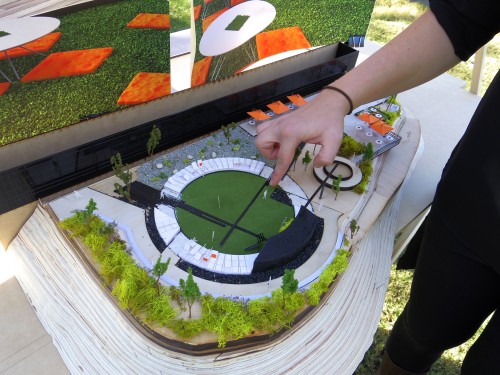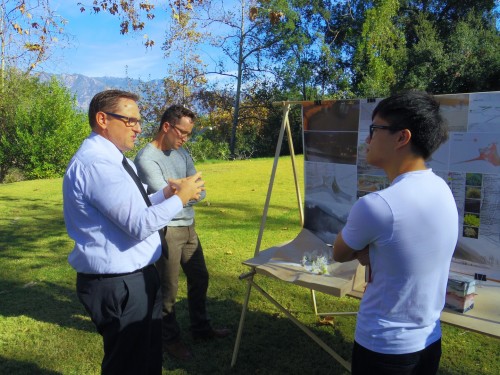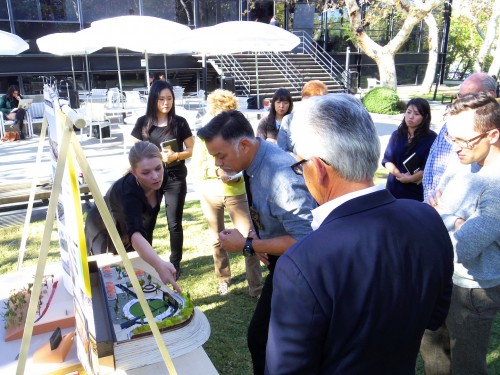
Environmental Design student Katie Healey’s design proposal for removing turf and expanding outdoor spaces for dining and recreation on the east side of the Ellwood Building.
Turf removal.
Not exactly a siren call to emerging designers regularly invited to put their brilliant minds to work developing sports cars, wearable tech and high-end furniture.
Or so one might assume.
A handful of Art Center students defied that assumption, and many others, as they enthusiastically explored possibilities for transforming Hillside Campus into an Eden of eco-innovation during last Fall’s Sustainability Studio.
Linda Estrada, an administrator who manages Art Center’s programs fostering alternative transportation options for campus commuters and other sustainability initiatives, got the ball rolling when she saw an opportunity to participate in a City of Pasadena program offering cash incentives—two dollars per square foot—to replace thirsty green lawns with drought-resistant plants and hardscape.
“And up here,” says Estrada, at Art Center over 17 years, “we have nothing but grass.”
A seasoned and passionate environmental advocate, Estrada knows culture change takes collective effort, so she often partners with other members of the campus community. In this case she reached out to the Environmental Design department, which offers an annual course in sustainable design. Although the 2014 course had already taken place in an earlier term, faculty member and SCI-Arc graduate James Meraz was excited by this particular challenge, and got approval for an additional class that would give students an opportunity for real-world impact right in their own water-stressed backyard: The 145-acre Hillside Campus includes 2.3 acres of lawn immediately surrounding the Ellwood Building, and another five landscaped acres along roadways and parking lots.
“Once a year, the Sustainability Studio has been focusing on public spaces, pocket parks and pavilions, in various contexts and conditions,” says Meraz, “so the groundwork in terms of understanding responsible landscapes, and spaces that are inviting and engaging to the communities they serve, was already a passion and concern. So when Linda presented this opportunity through the turf removal program, I was pleased to shape the curriculum to suit our needs.”
From the outset, firsthand research was key to students’ learning. To gain a deeper understanding of Southern California’s environment and the challenges it faces, both natural and manmade, the class made field trips to the Natural History Museum, to the Theodore Payne Foundation, and to Pasadena Department of Water and Power. Guest instructors included Shauna Turner, sustainable gardens artist and consultant; Marco Barrantes, who has been responsible for maintaining the rooftop garden at the Wind Tunnel building on South Campus; and Art Center Environmental Design alumnus Seth Baker (BS 13).
Humanities and Sciences instructor Siobhan Burke, a Yale-trained architect and LEED Accredited Professional, taught a sustainable building practices seminar that complemented the design studio led by Meraz. Together they encouraged students to treat this project as they would a professional assignment, with Art Center as the client. “Our students had this unique opportunity to collaborate directly with Art Center staff who oversee facilities and operations,” she says. “Designing for net-positive water is critical in this time of record drought. There are so many opportunities for designers to intervene with creative solutions to combating climate change.”
Using Survey Monkey to gather input from their fellow campus denizens, students made some surprising findings. In response to the question, “Where do you spend the majority of your time on campus outside of the classroom,” not a single answer gave a location outdoors. Asked which areas of the campus they would like to see developed, 60% of respondents put the outdoor dining area at the top of the list.
Upper-term student Katie Healey took those findings as the jumping-off point for her ambitious makeover of the patio dining area and the large swath of lawn that adjoins it—the very location where she and other students presented their projects on a sunny December morning during finals week.
“Most schools have a quad—here at Art Center we don’t,” says Healey, “so I really wanted to create a space to come together, a lounging area, a fitness area, an expanded dining area.” Based on a series of design moves inspired by the distinctive postmodern steel-and-glass structure of the Ellwood Building, Healey’s proposal features the use of bold geometric shapes and black steel beams, and replaces turf with drought-tolerant landscape, sustainable decking material and other hardscape.
Other proposals placed nature at the center. “I think the idea of individuals interacting with nature is crucial,” says student Haena Yoo. “Just walking around Hillside really opened my eyes. Being on-site and taking down measurements made me realize that even small under-used areas could be activated in new ways, giving a boost to creativity, health and quality of life.”
On a campus endowed with abundant trees and other untouched natural hillside vegetation, students were eager to create more opportunity for outdoor experiences—inviting spaces where people could stroll, hang out together or alone, or simply rest. One proposed a “sketch garden” under a shaded pergola constructed in part of corten steel beams (again, a nod to the Ellwood Building) that would be allowed to rust; another envisioned dining tables shaded by umbrellas by day, and illuminated by solar-powered lamps by night. Other projects included a memorial grove among the trees; a vertical garden built into the sign at the main entrance on Lida Street; and a newfangled speed bump on MacMinn—outfitted with a pressurized pump activated by the weight of passing cars—to move reclaimed water into a small, playground-like park.
Bold ideas are one thing. But, as Burke told one student after he finished his presentation, “Now let’s figure out the metrics.” She emphasizes that quantifying the potential impact of proposals is crucial to winning support from decision makers, whether it’s a project for Art Center or for any budget-conscious organization.

At left, Rollin Homer, director of real estate and campus planning, and Environmental Design alum Seth Baker gave Sean Chen feedback on his final project.
“The design brief asked: How we can use art and design to respond to changing climate and provide a richer, outdoor experience for our Art Center community?,” notes Director of Sustainability Initiatives Heidrun Mumper-Drumm. She and the entire faculty-and-staff team feel that students succeeded on both counts, creating sustainable yet sensorially and kinesthetically powerful experiences through their consideration of spatial design, materials, texture, color, even fragrance.
“I was just blown away by what the students came up with,” says Estrada. “It’s tough to say which design or combination of designs will be implemented.”
“All the projects were really interesting, above and beyond my expectations,” agrees Director of Facilities Jess Rivas. “I have master’s degrees in both architecture and facilities management, and was impressed by the projects from both of those perspectives. But at the end of the day, the balance is determined by economics and sustainability.”
While the turf removal program sparked the initial idea for the class, the students’ projects went well beyond that to explore student life at Hillside Campus and to propose, in the end, much larger-scale projects. Unfortunately the cost of implementing those concepts in full would far exceed the city’s rebates for turf removal.
So, as Art Center’s Facilities Committee considers the feasibility of implementing elements of various proposals, cost becomes the next big challenge.
Students and faculty are now preparing a publication that captures the studio’s three-pronged approach to sustainability—systems, materiality and experience—and the resulting proposals. “It will feature every project created in the class,” says Meraz, “from initial concepts, renderings and diagrams of sustainable systems employed, through to specific planting strategies, technical data, material/systems innovations and more.”
Ultimately, says Meraz, it’s not just about what designers put in, but what users take away. “What are the lasting impressions as we encounter the space? Can these impressions or experiences cause us to reconsider our environment and encourage stewardship?”









